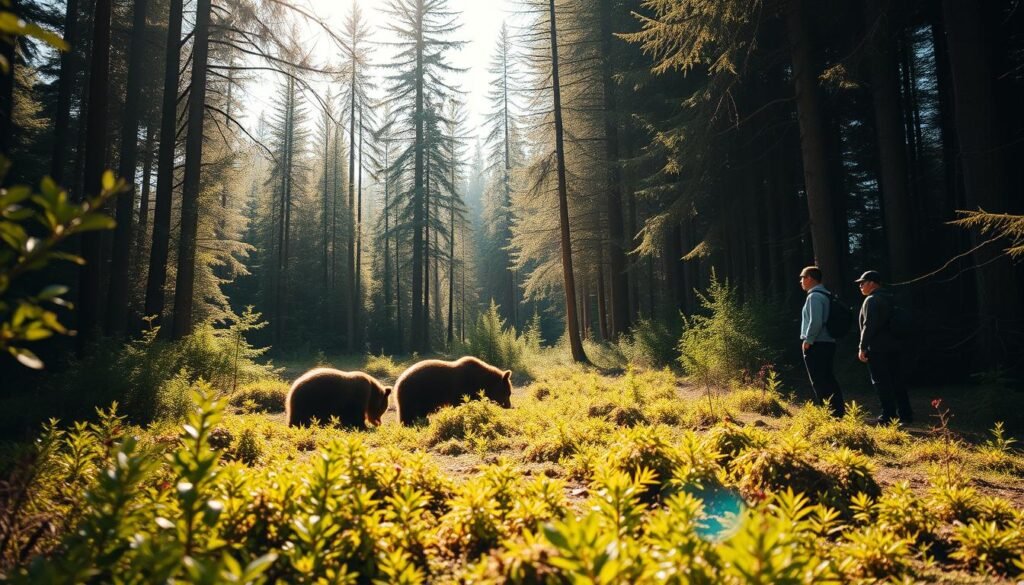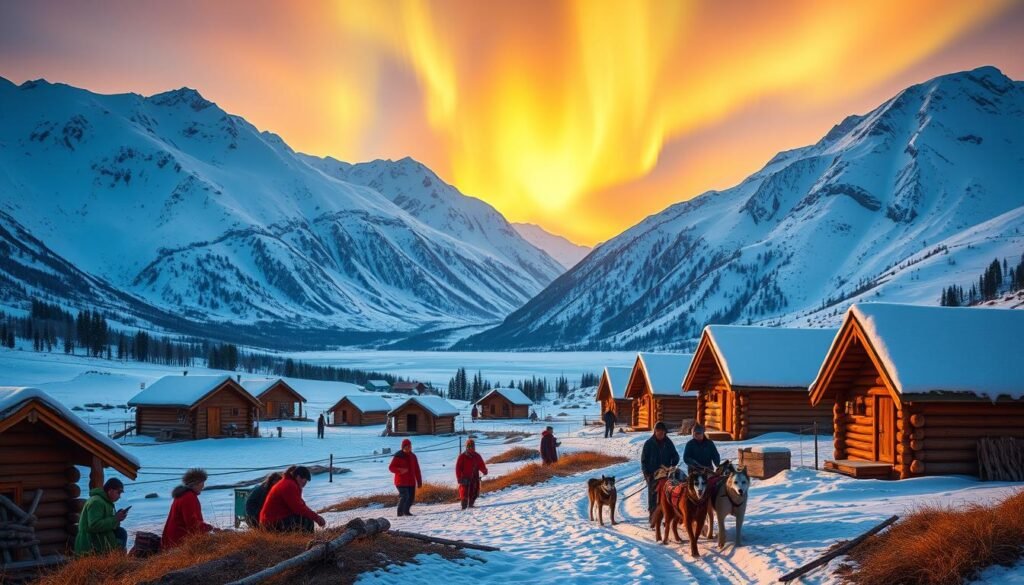Imagine walking through Alaska’s vast, untouched wilderness. Here, glaciers and fjords meet the eye. You’re not just seeing amazing views; you’re also helping local communities and conservation efforts. Ecotourism in Alaska mixes stunning nature with sustainable travel practices.
Traveling here lets you see the state’s wildlife and meet indigenous cultures. It also supports green travel. This way, Alaska’s beauty stays safe for the future.
Key Takeaways
- Explore Alaska’s vast wilderness while supporting local communities.
- Experience diverse wildlife and indigenous cultures.
- Promote environmentally friendly travel practices.
- Preserve Alaska’s natural wonders for future generations.
- Discover the unique blend of natural beauty and sustainable travel.
Understanding Ecotourism in Alaska
Alaska’s stunning natural beauty invites eco-aware travelers to join an adventure. This journey blends fun with caring for the planet. As you wander through this vast, untouched land, you’ll find a world celebrating nature through eco-friendly tours and alaska outdoor experiences.
What Makes Alaska Unique for Eco-Conscious Travelers
Alaska is a top spot for those who love the outdoors. Its huge wilderness, varied sea life, and rich wildlife make it perfect for eco-friendly travelers. You can see Alaska’s stunning landscapes and wildlife while supporting responsible tourism.
- Explore Alaska’s vast, untouched landscapes.
- See diverse marine life, like whales and sea lions.
- Learn about Alaska’s rich cultural heritage.
The Importance of Sustainable Practices in Fragile Ecosystems
Alaska’s ecosystems need careful and green tourism. By using sustainable practices, you can lessen your impact and help keep Alaska beautiful for others. This way, you make your trip better and help protect Alaska’s nature.
Some important green practices include:
- Reduce waste and recycle when you can.
- Pick tour operators that care for the environment.
- Respect wildlife and keep a safe distance.
By following these steps, you improve your trip and help protect Alaska’s delicate ecosystems.
When to Plan Your Eco-Friendly Alaskan Adventure
To see Alaska’s beauty and keep it safe, knowing when to go is key. Alaska’s wide and varied lands offer different experiences all year. Each season has its own special charm and things to think about for the environment.
Seasonal Considerations for Minimal Environmental Impact
The time of year you visit Alaska affects the environment. The shoulder season, from spring (April to May) to fall (September to October), is best. It has good weather and fewer people, which is better for the planet.
- Spring: See wildlife wake up and wildflowers bloom.
- Summer: Enjoy the midnight sun, but it’s the busiest time.
- Fall: See the harvest moon and wildlife move.
- Winter: Try snow sports, but think about the cold weather’s impact.
Peak Wildlife Viewing Periods
Alaska is famous for its many animals. Knowing when to see them makes your trip better.
Key times to see wildlife include:
- Bears coming out of hibernation in spring.
- Whale watching in summer.
- Caribou migrations in fall.
Weather Patterns and Packing Sustainably
Alaska’s weather is always changing. Packing smart and being ready for anything helps the environment.
Think about these when packing:
- Wear clothes that can be layered for changing weather.
- Use reusable and waterproof items.
- Choose eco-friendly personal care items.
By picking the right time to visit and packing wisely, you can have a great eco-friendly trip in Alaska. This trip supports wildlife conservation travel and green travel options.
Ecotourism in Alaska: Sustainable Travel Guide and Nature-Friendly Adventures
When you start your Alaskan adventure, knowing about ecotourism is key. It’s about enjoying the state’s beauty while keeping the environment safe. This way, you make your trip both fun and eco-friendly.
Essential Principles for Responsible Tourism
Responsible tourism in Alaska means following a few important rules. These rules help keep the state’s nature safe. They include:
- Minimizing waste and pollution
- Respecting wildlife and their homes
- Helping local communities and their businesses
- Protecting natural resources
By following these rules, you help Alaska’s tourism stay green. This way, you make your trip better for the planet.
Certifications and Organizations to Look For
There are groups and labels that support green tourism in Alaska. Look for places that have:
- The Alaska Tourism Industry Association (ATIA)
- The International Ecotourism Society (TIES)
- The Global Sustainable Tourism Council (GSTC)
These labels mean your travel choices are good for the planet and people.
Planning Your Itinerary with Sustainability in Mind
When planning your Alaskan trip, keep these tips in mind:
| Activity | Sustainable Alternative | Environmental Benefit |
|---|---|---|
| Guided Tours | Choose eco-friendly tour operators | Reduced carbon footprint |
| Accommodation | Opt for eco-certified hotels | Lower energy consumption |
| Transportation | Use public transport or shuttle services | Decreased air pollution |
By choosing wisely, you can have a great and green trip to Alaska.
Eco-Friendly Transportation Options
Eco-conscious travelers can cut down their carbon footprint by picking the right travel methods to and in Alaska. Think about the eco-friendly travel options when planning your trip.
Reducing Your Carbon Footprint While Traveling to Alaska
Flying to your destination is a big source of carbon emissions. While flying is often needed, you can offset your carbon emissions by supporting carbon offset projects or buying carbon credits. Some airlines let you offset your flight’s emissions on their websites.
For those coming from North America, train travel is a greener choice than flying. Amtrak’s Alaska Railroad isn’t connected to the U.S. rail network. But, you can take a train to a big city like Seattle and then switch to other green options.
Sustainable Ways to Explore Within the State
Once in Alaska, there are many ways to see the vast wilderness:
- Public transportation: Use public buses and shuttles to connect big towns and cities.
- Shuttle services: Many tour operators and lodges offer shuttle services to cut down road traffic.
- Carpooling and ride-sharing: Join or start carpooling and ride-sharing groups to lower carbon emissions.
- Biking and walking: Explore on foot or by bike. It’s eco-friendly and lets you see local culture and views.
Public Transportation and Shuttle Services
Alaska has a good public transport system with buses and shuttles to major spots. Here’s a quick look at some options:
| Service | Description | Frequency |
|---|---|---|
| Alaska Bus Company | Offers bus services between major cities and towns | Daily |
| Alaska Shuttle | Provides shuttle services to and from airports and popular spots | Multiple times a day |
| Local Transit Systems | Various local bus systems within cities like Anchorage and Juneau | Varies by city |
By picking these eco-friendly travel options, you lower your environmental impact. You also get a better travel experience by connecting more with local environments and communities.
Green Accommodations and Lodging Choices
Your choice of lodging in Alaska is key to responsible tourism. It helps local communities and cuts down on carbon emissions. Think about eco-friendly places to stay, like green hotels and camps.
Eco-Certified Hotels and Lodges
Alaska has many eco-certified hotels and lodges that follow strict green rules. They offer cozy stays and use green tech, like energy-saving lights and local materials.
- Look for certifications like LEED or Alaska’s Green Business Program.
- Choose hotels that use renewable energy sources.
- Support lodges that help protect local wildlife.
Sustainable Camping and Glamping Experiences
For a true outdoor adventure, Alaska has sustainable camping and glamping spots. These places use green practices, like composting toilets and recycling.
- Opt for campsites with minimal environmental impact.
- Consider glamping options that use sustainable materials.
- Always follow Leave No Trace principles.
Supporting Local and Family-Owned Accommodations
Choosing local and family-owned accommodations helps the local economy. These places know the area well and share tips on green living and outdoor fun.
- Research family-owned lodges and hotels.
- Engage with local owners to learn about their sustainability efforts.
- Share your positive experiences to promote responsible tourism.
By picking the right place to stay, you make your Alaska trip better. You also help the local economy and environment.
Responsible Wildlife Viewing Practices
Exploring Alaska’s vast wilderness means we must care for it for the future. Alaska is home to many animals, like bears, moose, whales, and eagles. Watching wildlife can be exciting, but we must do it right to protect animals and their homes.

Ethical Bear Watching Guidelines
When watching bears, keep a safe distance to not stress them out. Stay at least 100 yards away and never go near them, even if they seem friendly. Guides can offer great advice and help you watch responsibly.
Be aware of your surroundings and keep quiet to avoid scaring bears. Use bear spray only as a last resort and know how to use it right. Always follow local rules for bear watching.
Marine Wildlife Observation Ethics
Seeing whales and sea lions is a highlight of Alaska. To watch them right, pick tours that are good for wildlife. Keep a safe distance and never touch or feed them to keep their natural ways.
Be careful with your boat’s speed and how close you get to wildlife. Slow down and keep a safe distance to protect marine life. Supporting conservation and respecting protected areas are key to watching marine wildlife right.
Bird Watching with Minimal Disturbance
Bird watching is popular in Alaska, with many birds to see. To not disturb them, stay on trails and avoid restricted areas. Use binoculars to watch birds from far away.
Try to be quiet and patient to watch birds without stressing them. Avoid sudden movements or loud noises that can scare them away.
Photography Ethics in Natural Settings
Photography is a great way to capture Alaska’s wildlife beauty, but it must be done right. Don’t use flash, as it can scare animals. Instead, use natural light or adjust your camera settings.
Take your time to observe and capture moments without disturbing animals. Follow any photography rules, even in protected areas. This way, you can enjoy photography while helping protect Alaska’s wildlife.
Sustainable Outdoor Activities and Adventures
Exploring Alaska’s vast wilderness offers many chances for sustainable outdoor fun. The state has activities that thrill and help protect the environment.
Low-Impact Hiking and Backpacking Trails
Alaska boasts some of the world’s most stunning hiking trails. To leave a small footprint, pick trails that are well-kept and follow local conservation advice. Denali National Park and Tongass National Forest have great options.
- Research trails before heading out to avoid sensitive habitats.
- Stick to designated trails to prevent erosion.
- Pack out all trash and leftover food.
Eco-Friendly Water Adventures: Kayaking and Rafting
Alaska’s clear waters are perfect for kayaking or rafting. These activities give a close look at marine life and glaciers. Choose operators that use eco-friendly practices and support conservation.
Some top eco-tour operators include:
- Kayak Alaska
- Alaska Rafting Expeditions
Sustainable Winter Activities: Snowshoeing and Cross-Country Skiing
Winter in Alaska is great for snowshoeing and cross-country skiing. These activities let you see the beauty of snow-covered landscapes. Alyeska Resort and other ski resorts offer sustainable options and rentals.
Vetted Eco-Tour Operators and Experiences
When picking an eco-tour operator, look for certifications from groups like the Alaska Ecotourism Association or the International Ecotourism Society. These operators focus on responsible tourism that helps the environment and local communities.
| Operator | Activity | Certification |
|---|---|---|
| Kayak Alaska | Kayaking | Alaska Ecotourism Association |
| Alaska Rafting Expeditions | Rafting | International Ecotourism Society |
| Alyeska Resort | Skiing/Snowshoeing | Alaska Green Business Partnership |
Supporting Indigenous Communities and Conservation Efforts
Exploring Alaska’s vast wilderness lets you support local communities and conservation. This enriches your trip and helps preserve Alaska’s culture and environment.

Cultural Experiences That Give Back to Native Alaskan Communities
Connecting with Native Alaskan communities is rewarding for both you and them. Many offer cultural experiences to share their traditions and history. These experiences support the communities and help keep their heritage alive.
- Attend a traditional dance performance or music event hosted by a Native Alaskan community.
- Participate in a workshop where you can learn traditional crafts such as carving, weaving, or basket-making.
- Visit a Native American-owned business or cultural center to support local entrepreneurs.
By joining in these cultural experiences, you directly help the communities. You also ensure their traditions continue.
Purchasing Authentic and Sustainable Souvenirs
Choosing authentic and sustainable souvenirs is key. It supports local artisans and helps the environment.
Tips for Sustainable Souvenir Shopping:
- Look for products made from sustainable materials or those that promote eco-friendly practices.
- Purchase items directly from Native Alaskan artisans or local businesses.
- Avoid buying products made from endangered species or those that contribute to environmental degradation.
Being mindful of your souvenir choices helps the local economy. It also supports sustainable practices.
“The land is our bank, our livelihood. When you buy from us, you’re not just buying a product, you’re supporting our way of life.” – Native Alaskan Artisan
Volunteer Opportunities for Conservation-Minded Travelers
Alaska has many volunteer chances for those who want to help. These projects protect and preserve Alaska’s natural beauty.
- Wildlife conservation projects, such as monitoring animal populations or participating in habitat restoration.
- Environmental clean-up initiatives, focusing on removing trash and debris from natural areas.
- Community-based projects that support local conservation efforts and promote sustainable living practices.
Volunteering helps Alaska’s ecosystems and lets you appreciate its beauty more.
In conclusion, supporting indigenous communities and conservation is key in Alaska. Engaging in cultural experiences, buying sustainable souvenirs, and volunteering make a difference. They also enhance your travel experience.
Conclusion: Embracing the Spirit of Ecotourism in Alaska
Planning a trip to Alaska means more than just a journey. It’s joining a movement towards sustainable travel. Here, you’ll find nature-friendly adventures and cultural experiences that connect you with the land and its people.
Choosing eco-friendly options like green transportation and accommodations helps local communities and conservation. You also help protect Alaska’s delicate ecosystems. This way, future generations can enjoy the same stunning landscapes and wildlife.
This article has shown how to travel sustainably in Alaska. By following ecotourism principles, you positively impact the environment and communities. This makes your travel experience more meaningful and enriching.
Exploring Alaska’s vast wilderness means your choices have an impact. By making smart, sustainable choices, you support nature and environmental care. This promotes a culture of caring for our planet.

















Leave a Reply